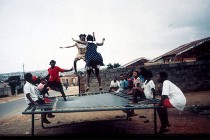
|
Jo´burg Now! Building Site South Africa Press Conference: Wednesday, 04 August 2004, 11am Opening: Wednesday, 04 August 2004, 7pm Exhibition: 05 August - 27 September 2004 Opening Hours: daily 10.00 am - 07:00 pm, Wedn. 10:00 am -09:00 pm Press Release In 1994 the South African apartheid system, and with it white supremacy, were ended with the country's first free elections, held under President Nelson Mandela. Today, 10 years later, the multi-ethnic state of South Africa is on the difficult path towards democracy. The exhibition "Jo’burg Now! Building Site South Africa” in the Architekturzentrum Wien takes a look at the metropolis of Johannesburg, which can be seen as a microcosm of the country as a whole and also as a kind of cultural kaleidoscope of both past and future. Johannesburg is a city of extremes: despite the stamp left by the decades of injustice under the apartheid system it is an example for other cities in the Third World. In addition, this city shows how extreme social contrasts can be reconciled by varied initiatives undertaken in specific functional contexts. A project by the department of housing and design at Vienna University of Technology's school of architecture takes a closer look at the situation. In the framework of this initiative two buildings were erected for Orange Farm township in Johannesburg. This project is closely related to the exhibition "Just build it! The Buildings of Rural Studio” that the Az W presented with great success in 2003: here the Az W initiated an appeal for the inclusion of architectural social intervention in the architecture curriculum. In the context of a new emphasis on social commitment in the education of architects, the intention is that students should carry out (under typically restricted conditions) projects aimed at providing high-quality architecture for socially under-privileged groups or persons. THE EXHIBITION The first part of the exhibition, previously shown at the 5th Architecture Biennial in Sao Paolo in 2003 by a Johannesburg-based team of architects (Thorsten Deckler, Anne Graupner, Henning Rasmuss), will present the development of the city, its special qualities and contradictions. The young city of Jo’burg (founded only in 1886) has, in its relatively short history, completed a metamorphosis from a colonial centre of capital to a city whose structures were shaped by the policy of apartheid, and which, since 1994, is undergoing the process of transformation into a democratic society. Jo’burg is in a sense representative of South Africa, which is a showpiece for peaceful revolution. Despite all the problems evident in the country – and in Johannesburg in particular – such as the extreme social segregation, a positive picture is made of a city in a state of change, a metropolis with many different ethnic groups in which existing structures and substance must be re-programmed and current problems actively tackled. Recent urban projects and architectural responses to the planning and social challenges of the present are featured in the exhibition alongside projects showing the wild beauty of the industrial landscape. Large-scale display panels, photo-essays and documents are used to paint a differentiated portrait of Johannesburg's exciting history. Against this background two projects will be presented that were recently completed in Johannesburg by the housing and design department of the architecture faculty, Vienna University of Technology: under the guidance of architects Peter Fattinger, Sabine Gretner and Franziska Orso 25 architecture students developed two social buildings for "Orange Farm”, a typical township of the post-apartheid era on the periphery of Johannesburg. The aim of the project was, starting with a preparatory theory and design phase in Vienna, to build on site facilities urgently required by the township using simple, inexpensive, local building materials and innovative and experimental detail solutions. The students erected a multi-functional building for Masibambane College. It consists of two bedrooms – each for four people, covered terraces with integrated cooking facilities and seating areas, lavatories and a viewing terrace above the building that is accessed by various climbing walls. An outdoor classroom with stage completes the complex. For Modimo o Moholo, an organisation for the disabled based in Orange Farm, the students built a day care centre with a floor area of 250 m_ divided up into three elements that form a sheltered internal courtyard. In addition to the generously dimensioned common room and workspace, additional areas sheltered from the elements allow people to work outdoors. Sanitary, storage and office spaces are connected to each other by large roofs. "The best thing about the whole experience is the feeling that you are making something that’s really needed, doing something that makes sense” (one of the students involved). The construction process is documented using numerous video clips and photo sequences and an insight is also provided into Orange Farm township. An installation by the students erected in the Az W courtyard illustrates the inequalities of real-life situations in Johannesburg. Concept Johannesburg Now: Thorsten Deckler, Anne Graupner, Henning Rasmuss Concept Orangefarm: Peter Fattinger, Franziska Orso Projectcoordination Az W: Caroline Kufferath, Alexandra Viehhauser Patrons of the exhibition: South African Embassy, Helmut Zilk Fund for International Relationships, Schnauer Raumzellenbau GmbH. |
 |
|
© Thorsten Deckler |
|
Press page Current events Past events Gallery: Press images Jo´burg Now Dates: Jo'burg Now! Downloads: Press Release - Jo´burg Now! Information: Ines Purtauf Tel.: +43 (1) 522 31 15 - 25 Fax: +43 (1) 522 31 17 Email: purtauf@azw.at |
| © Architekturzentrum Wien 2025 |
||



